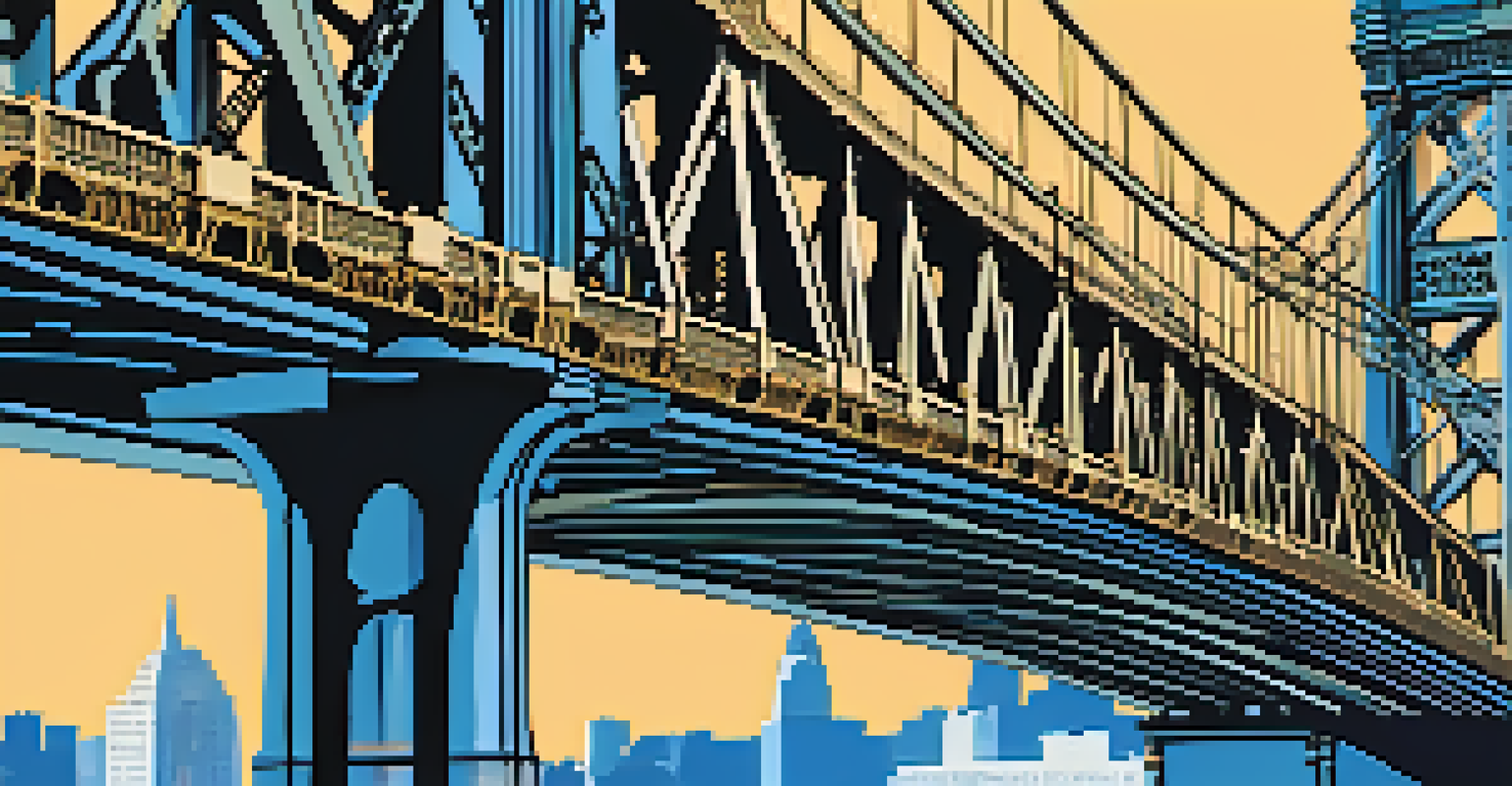Historic Bridges of New York City: Connecting Communities

The Role of Bridges in Urban Development
Bridges have always played a crucial role in the expansion of New York City. They serve not just as physical structures but as vital links that foster community growth and connectivity. As neighborhoods developed, these bridges became essential for commerce, travel, and social interaction, shaping the city's landscape.
Bridges are not just connections between two points; they are the pathways to our future.
Take, for instance, the Brooklyn Bridge, which opened in 1883 and connected Manhattan and Brooklyn. This monumental feat of engineering not only facilitated easier movement but also contributed to the economic boom of the surrounding areas. Without such connections, many neighborhoods would have remained isolated, stunting their growth.
Ultimately, bridges symbolize more than just transportation; they represent the spirit of collaboration and innovation that has defined New York City throughout its history.
Brooklyn Bridge: An Engineering Marvel
The Brooklyn Bridge is perhaps the most iconic of New York's historic bridges. Spanning over 1,800 feet, it was the first steel-wire suspension bridge constructed, showcasing the ingenuity of its time. Designed by John A. Roebling, it serves as a testament to human ambition and creativity.

Walking across the Brooklyn Bridge offers stunning views of the Manhattan skyline, making it a popular destination for tourists and locals alike. The bridge also holds a special place in the hearts of New Yorkers, symbolizing resilience and unity. Its construction faced numerous challenges, including the untimely death of Roebling, yet it was completed by his son, Washington Roebling.
Bridges Enhance Urban Connectivity
Bridges in New York City serve as vital links that foster community growth and connectivity, shaping the city's landscape.
Today, the Brooklyn Bridge stands not only as a functional crossing but as a cultural landmark, frequently featured in films, literature, and art, illustrating how bridges can transcend their practical purpose.
Manhattan Bridge: A Hub of Transportation
Completed in 1909, the Manhattan Bridge serves as a critical transit route between Manhattan and Brooklyn. Unlike the Brooklyn Bridge, which is primarily a pedestrian and vehicle thoroughfare, the Manhattan Bridge was designed with a focus on heavy rail transit, making it essential for commuters.
The bridge is a symbol of effort and collaboration; it reminds us that we can achieve great things when we work together.
The bridge is adorned with striking Art Deco design elements that reflect the era's architectural trends. With its distinctive blue color and sweeping arches, it has become a beloved part of the city's skyline. The Manhattan Bridge also features a pedestrian walkway, allowing visitors to enjoy panoramic views of the East River.
In recent years, the bridge has undergone significant renovations to preserve its historical integrity while improving its functionality. This ongoing commitment to maintenance ensures that it continues to serve the community for generations to come.
Williamsburg Bridge: A Cultural Connector
The Williamsburg Bridge, completed in 1903, has often been referred to as a cultural connector between the diverse neighborhoods of Manhattan and Brooklyn. Originally built to accommodate streetcars, it has evolved over the years to meet the demands of a growing population.
This bridge has witnessed the transformation of the surrounding areas, from industrial hubs to vibrant cultural centers. The neighborhoods it connects, such as Williamsburg and the Lower East Side, are known for their rich artistic communities, making the bridge a symbol of cultural exchange.
Historic Bridges Reflect Cultural Identity
Each historic bridge, like the Brooklyn and Williamsburg Bridges, represents not only engineering feats but also the cultural exchange and resilience of the neighborhoods they connect.
With its dedicated bike lane and pedestrian walkway, the Williamsburg Bridge invites countless cyclists and walkers each day, reinforcing its role as a community space. It’s a lively thoroughfare, where the sounds of music, conversation, and laughter create a unique atmosphere that reflects the city's spirit.
Queensboro Bridge: The Iconic '59th Street Bridge'
The Queensboro Bridge, often affectionately called the '59th Street Bridge,' is a stunning example of cantilever bridge design. Completed in 1909, it connects Manhattan's Midtown East with Queens, making it a vital transportation link for commuters and visitors alike.
One of the bridge's most notable features is its unique views of the city, showcasing both the East River and the iconic skyline. Its vintage charm and historical significance make it a favorite subject for photographers and filmmakers. Many know it from the Simon & Garfunkel song '59th Street Bridge Song,' which captures the essence of the city.
As a result of its design and location, the Queensboro Bridge has become an integral part of the city's identity, embodying the blend of culture and engineering that New York City is renowned for.
George Washington Bridge: A Gateway to New Jersey
The George Washington Bridge is not just a remarkable feat of engineering; it serves as a crucial gateway between New York City and New Jersey. Opened in 1931, it features the longest main span of any suspension bridge in the world, making it a vital transportation corridor.
What’s fascinating about the George Washington Bridge is its role in daily commutes. Millions of vehicles traverse this bridge each year, highlighting the interconnectedness of the metropolitan area. The views from the bridge are breathtaking, offering a unique perspective of the Hudson River and the surrounding landscapes.
Preservation Ensures Future Relevance
Efforts to preserve and maintain New York City's historic bridges highlight their significance as integral pieces of the city’s identity and community.
Despite its heavy use, the bridge also serves as a reminder of the importance of infrastructure in community building. Its expansive design and accessibility illustrate how bridges can enhance connectivity and foster economic growth in surrounding areas.
Historic Preservation: A Commitment to the Past
Preserving the historic bridges of New York City is essential for maintaining the city's rich heritage. Organizations and city officials work tirelessly to ensure that these iconic structures are protected, restored, and celebrated for future generations. Preservation efforts often involve thorough assessments and renovations that respect the original design while upgrading safety features.
Through community initiatives and educational programs, local residents are encouraged to engage with the history of these bridges. Events, guided tours, and workshops highlight their significance, fostering a deeper appreciation of how they have shaped the city’s development.

As we look to the future, the commitment to preserving these historic bridges reminds us that they are more than just pathways; they are integral pieces of New York City's identity, connecting us to our past while supporting our present and future.
The Future of NYC's Historic Bridges
As New York City continues to evolve, the historic bridges remain vital to its infrastructure and community connection. Innovations in technology and design are paving the way for enhanced accessibility and sustainability in bridge maintenance and operations. These advancements ensure that these iconic structures can adapt to the changing needs of the city.
Moreover, with growing interest in pedestrian and cycling pathways, plans for improving access to these historic routes are underway. This shift not only promotes healthier modes of transportation but also encourages residents to engage with their surroundings.
In embracing the future while honoring the past, New York City's historic bridges will continue to stand as enduring symbols of connection, resilience, and community for years to come.